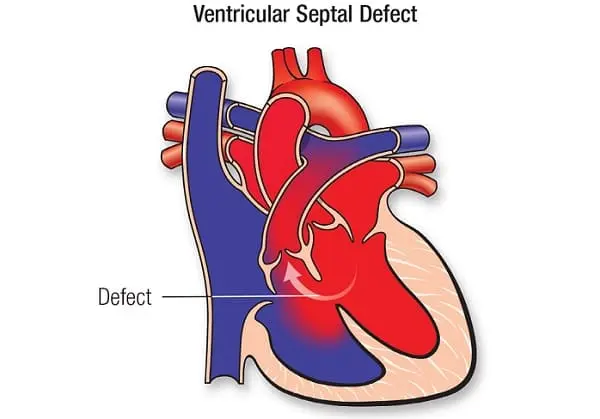A Ventricular Septal Defect or VSD is a condition wherein one is born with a hole in the wall separating the heart's bottom chambers. If the hole is enlarged enough, the amount of blood leakage between them is more, causing lifetime damage to the lungs and heart and enhancing the risk of heart infections.
One with a ventricular Septal Defect may experience minor or no symptoms if it is small. In the case of a large hole, you may need to be repaired it to prevent complications and permanent damage. In infants, moderate to large VSD leads to heart failure. The symptoms and signs of this condition include failure to thrive, fatigue during feeding, sweating, shortness of breath, struggle to breathe, and frequent respiratory infections.
While in adults and older children, the symptoms will be different. These include the maximum risk of heart inflammation, easy breathlessness, tiredness, etc. However, a few VSDs are less harmful and cause minor problems. When one can reach the age of 6 years, the hole will close on its own. In most cases, a doctor will suggest monitoring for signs, but they may recommend surgery if the defect cannot close on its own.
If the condition is severe, your healthcare provider may recommend surgery. And the ventricular septal defect surgery cost in India is around INR 3 00,000, going up to INR 7 00,000. This cost is estimated but will vary depending on complications, tests, reports, hospital goodwill, surgeon, and case to case.
VSD is a medical condition that occurs early due to heart conditions, heart defects, and genetic disorders. The reason that may cause VSD to include if the mother is taking too much alcohol during pregnancy or consuming specific anti-seizure medications.
Depending on a mix of signs, imaging tests, and physical examination, it can be detected whether they are large or medium. But, if the hole is too small, the VSD may be patchy, resulting in no signs or minimal symptoms.
To search for a VSD, doctors usually do a physical exam. This is the best way to detect the condition, especially if the VSD is medium or large because it causes a sound called a heart murmur. During a physical examination, the doctor can listen to it using a stethoscope.

Closing the hole is the only way to treat large or moderate-sized holes. There are two ways to treat VSD: surgery and transcatheter procedures.
The most appropriate way to treat a hole in the heart is to close it surgically. To do this, your healthcare provider (cardiac surgeon) will operate on and close it. Depending on the hole's location and size, closing the hole can be just as simple and reliable. Some cases require the incorporation of grafts of the human's own tissue or a patch designed of synthetic material.
This procedure is similar to cardiac catheterization and serves as access to the heart through a vital artery. Once the catheter instrument is in the hole, it can hold a special instrument in place and plug the defect. Such devices are usually designed using synthetic materials having framework corners.
The following method, including the device or patch, will eventually form the inner part of the heart wall between the ventricles.
Q1. What are the side effects/complications of VSD?
Ans: You should consult your healthcare provider to know possible complications, risks, and side effects. With medications, it is possible to experience unpleasing side effects. Some common side effects of VSD treatment (surgery or procedures) include infections (heart infections), bleeding, heart rhythm issues, disruption of nearby heart valves, etc.
Q2. Can the risk of VSD be reduced?
Ans: Actually, not! You can prevent it by avoiding alcohol. If you are pregnant, don’t take anti-seizure medications.
Q3. How do I take care of myself during a VSD situation?
Ans: It is best to consult with your healthcare provider for guidance on relieving symptoms and taking care of yourself. People with VSD are usually advised to avoid excessive physical activity as well as to rest. They should also avoid activities that put too much strain on their heart. They should also avoid activities that put too much strain on their heart. In addition, it is important to take medications as prescribed and stop taking them if your healthcare provider only recommends so.
Q4. Which test or diagnosis helps you know about VSD?
Ans: Apart from physical examination, testing VSD can be done with imaging tests. These include:
Other tests that help diagnose VSD include Heart/Chest X-ray, CT Scan, and Cardiac catheterization.